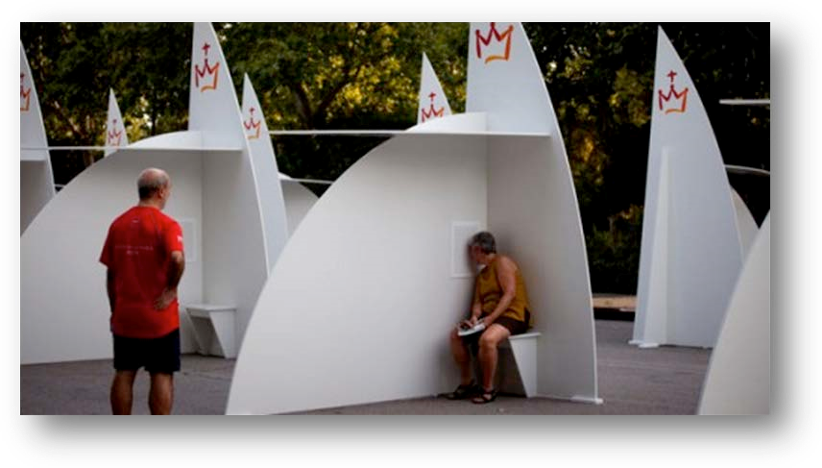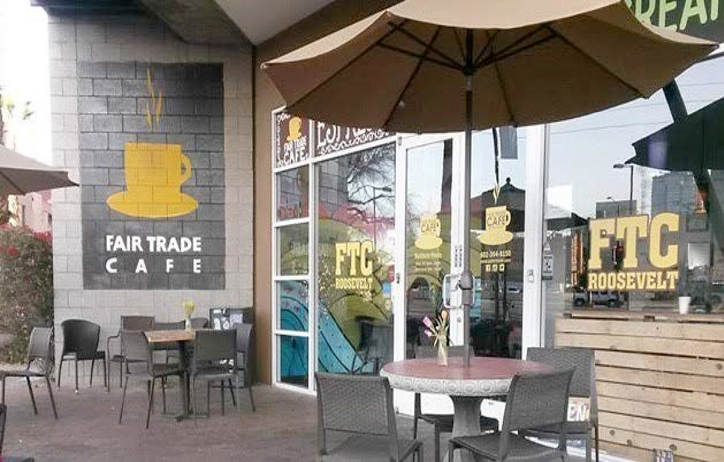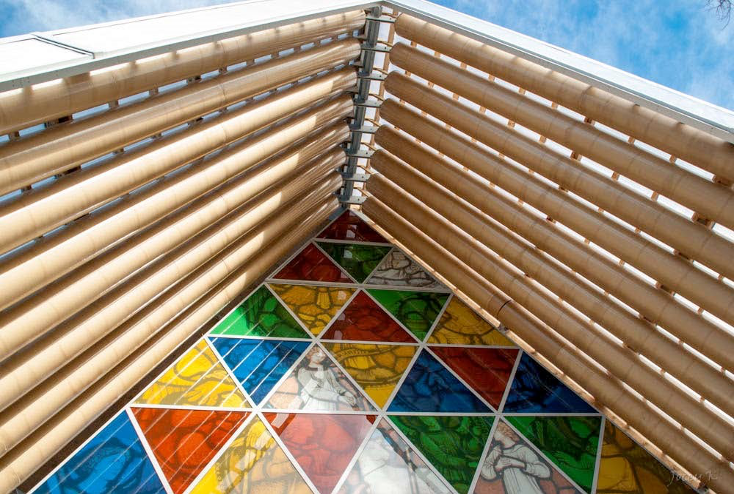Shauna Lee Lange
Summary Statement: Where, by economic, political, or other restrictions or constraints, an individual or a community cannot “go” to traditional sacred worship places, then creativity and human engineering must be employed to bring temporary worship places to a community. In this intensive and visually rich curated presentation, we examine the nature, structure, craft, and aesthetic artistry of mobile faith, temporary faith structures, and make-shift faith placemaking around the world in exploring and viewing new ideology and techniques in what constitutes (and replaces) the traditional church, synagogue, or worship sanctuary. If the world economic divide is a tipping point for the increasing causality of independent pop-up “sacred” structures, what can be learned from various examples of portables for advancing spiritual effectiveness, architectural craft, and culture within form, function, and faith?
Scope: A house of faith is designed to provide comfort, safety, strength, hope, and refuge. What happens when there’s no house… no permanent fixed structure immediately available? If necessity is the mother of invention in a day of small church closings and the concurrent rise and fall of metropolitan mega-churches, what are the drivers for worship delivery to disenfranchised populations? Form, function, faith, creativity, or the human facility to name and claim sacred ground? Creative pop-up faith structures gain in scope, number, and employment. What needs are driving these make-shift entities? Where more than 1 in 4 people worldwide are currently in substandard housing conditions, the mega church is not sustainable as universal faith and worship answers. Most people are spread within rural communities, Third-World populations, and remote environments with reduced access to sacred spaces to cater to their needs. In exploring a visual survey of subject-focused images, pop-up faith placemaking (and its relation to specific doctrine) will be narrated with an authorial voice as to artistry, craft, and ultimate employability.
Figure 1. The Architects Newspaper featured a 2011 article wherein 200 pop-up confessional booths were employed in a public square in Madrid.i Criticism over church spending on festivals contrasted to austerity measures.
Figure 2. Added to economic drivers are age-based factors for creating pop-ups, such as the 2015 example found in The Christian News Journal wherein a pop-up church was successful in reaching disenfranchised Millennials with generationally different motivations at a Fair Trade Café in Phoenix. ii
Figure 3. In 2013, Gail Irwin discussed the sad realities of empty churches and noted a temporary cardboard church erected with creativity and craft in New Zealand. This “temporary” structure was architecturally designed to last 50 years to enable the congregation to recover funds to rebuild from fire calamity. iii
Figure 4. From developed nations we turn to Third-World migrant refugee sacred houses. In
2015, The Guardian shared powerful images of a church for Ethiopian and Eritrean Christians, constructed from on-hand materials. The “building” speaks to the vulnerable feeling cold and unwelcome and the experience of being a migrant in hostile and foreign environments. The structure is utilitarian and carries over elemental cornerstones of churches. iv
Figure 5. The rapid-moving slide-show will continue with additional visual examples in a range of architecture, culture, craft, spirituality, and artistry, as shown in this final descriptive abstract example of a mobile church on wheels. Even mobile bus ministries are yesterday’s news. Mobile increasingly becomes about what’s economically doable on the Road to Damascus via motorcycle, tiny structures, bicycles, and more.v
Intended Conclusions: Temporary and portable worship structures will increasingly be highly integral parts of the future because they reduce costs, allow flexibility, and channel more funds toward ministry. They also welcome the unchurched, foster better community engagement, shape a clearer church identity, and keep vision independent of any one building. Pop-up, temporary, mobile worship serves to encourage thriving relationships, mobilize volunteers, and unleash maker creativity. vi Opposing arguments may be made that cheap, temporary churches instill cheap, temporary faith.vii This paper demonstrates that even if that sentiment is true, any creative structure (or broader form of public art for worship, such as make-shift street- side memorials for celebrities or mass-casualties) for any level of faith worship is immeasurably more valuable and necessary for service and growth than no faith place at all. A focused survey study of POP-UPs will contribute to broader meanings of built works in changing environments.

Figure 1: Pop-up Confessionals in Madrid

Figure 2: Phoenix Pop-Up Church in a Fair Trade Café

Figure 3: New Zealand Temporary Cardboard Church

Figure 4: Calais Ethiopian Orthodox Church

Figure 5: India Motorcycle Ministry
i
The Architects Newspaper, (Editors). “Forgiveness, Hiroshima, Farmers Markets, & Missing Maps”, 16 Aug 2011, as seen at https://archpaper.com/2011/08/quick-clicks-forgivenesshiroshima-farmers-markets-missing-maps/ on 12 Jan 17. Photo credit for Figure One: Marta Ramoneda/NYTimes. ii
Hendricks, Shawn (BP). Christian News Journal, ‘Pop up Church’ Aims to Reach Millennials, , 3 Feb 2015, as seen 12 Jan 17 at http://christiannewsjournal.com/pop-up-church-millennials/. Photo credit for Figure Two: Facebook (true source unknown). iii
Irwin, Gail. From Death to Life, Churches Facing Resurrection, “A Temporary Church”, 20 Aug
2013, as seen at https://freelancepastor.wordpress.com/2013/08/20/a-temporary-church/ on 12 Jan 17. Photo credit for Figure Three: Jocelyn Kinghorn. See detailed photos of the structure at http://gizmodo.com/inside-the-cardboard-church-that-replaced-an-earthquake-1047065519. iv st
Fraser, Giles. The Guardian, “A 21 -century Exodus: What the Makeshift Calais Camp Church Means”, 4 Aug 15, as seen at https://www.theguardian.com/world/2015/aug/04/a-21st-centuryexodus-what-the-makeshift-calais-camp-church-means on 12 Jan 17. Photo credit for Figure
Five; Rob Stothard/Getty Images v
Stark, William. Persecution International Christian Concern, “Crossing the Bridge: How to Build a Church on Wheels: Encountering God’s Spirit on a Missionary’s Motorcycle” 02 May 13, as seen at http://info.persecution.org/blog/bid/288911/How-to-Build-a-Church-on-WheelsEncountering-God-s-Spirit-on-a-Missionary-s-Motorcycle on 12 Jan 17. Photo Credit for Figure Seven, Author.
vi
Portable Church Industries (Editors). “10 Sensible Advantages Churches on Wheels Have Over Permanent Venues”, 23 May 16, as seen at http://www.portablechurch.com/2016/churchlaunch/mobile-church-advantages/ on 12 Jan 17. vii
Longenecker, Fr. Dwight. “How Cheap Temporary Churches Instill Cheap, Temporary Faith”, 2 Jun 15, as seen at http://aleteia.org/2015/06/02/how-cheap-temporary-churches-instill-cheaptemporary-faith/ on 12 Jan 17.
Anderson, Keith. “The Digital Cathedral: Networked Ministry in a Wireless World,” (Morehouse Publishing, 2015)
Eliade, Mircea. The Sacred and the Profane (New York: Harcourt, Brace & World, 1959)
Kilde, Jeanne Halgren. “A Method of Thinking About Power Dynamics in Christian Space,” in
Sacred Power, Sacred Space: An Introduction to Christian Architecture and Worship (Oxford: University Press, 2008), discusses the concept of “situational” sacred space)
Miles, Sara. City of God: Faith in the Streets (New York: Jericho Books, 2014)



